
Flammulina filiformis is a species of edible agaric in the family Physalacriaceae. It is widely cultivated in East Asia, and well known for its role in Japanese and Chinese cuisine. Until recently, the species was considered to be conspecific with the European Flammulina velutipes, but DNA sequencing has shown that the two are distinct.

The Boletaceae are a family of mushroom-forming fungi, primarily characterised by small pores on the spore-bearing hymenial surface, instead of gills as are found in most agarics. Nearly as widely distributed as the agarics, the family is renowned for hosting some prime edible species highly sought after by mushroom hunters worldwide, such as the cep or king bolete . A number of rare or threatened species are also present in the family, that have become the focus of increasing conservation concerns. As a whole, the typical members of the family are commonly known as boletes.

Suillus is a genus of basidiomycete fungi in the family Suillaceae and order Boletales. Species in the genus are associated with trees in the pine family (Pinaceae), and are mostly distributed in temperate locations in the Northern Hemisphere, although some species have been introduced to the Southern Hemisphere.
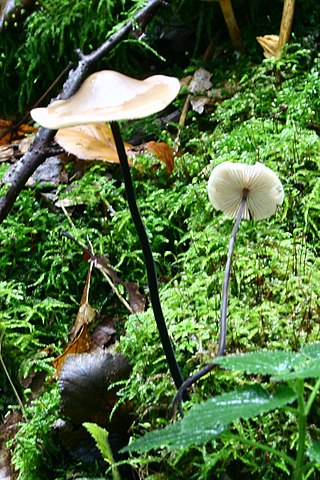
Mycetinis alliaceus, commonly known as the garlic parachute, is one of the larger mushrooms formerly in the genus Marasmius, having a beige cap of up to 4 cm and a long tough slender stipe. It emanates a strong smell of garlic, and this is the significance of the Latin species name, alliaceus. It is distributed throughout Europe, being fairly common in some areas and quite rare in others.

The Physalacriaceae are a family of fungi in the order Agaricales. Species in the family have a widespread distribution, ranging from the Arctic, (Rhizomarasmius), to the tropics, e.g. Gloiocephala, and from marine sites (Mycaureola) and fresh waters (Gloiocephala) to semiarid forests (Xerula).
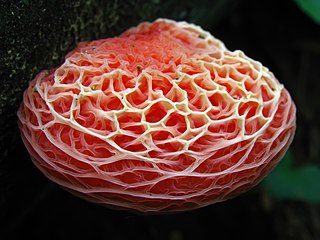
Rhodotus is a genus in the fungus family Physalacriaceae. There are two species in the genus with the best known, Rhodotus palmatus, called the netted rhodotus, the rosy veincap, or the wrinkled peach. This uncommon species has a circumboreal distribution, and has been collected in eastern North America, northern Africa, Europe, and Asia; declining populations in Europe have led to its appearance in over half of the European fungal Red Lists of threatened species. Typically found growing on the stumps and logs of rotting hardwoods, mature specimens may usually be identified by the pinkish color and the distinctive ridged and veined surface of their rubbery caps; variations in the color and quantity of light received during development lead to variations in the size, shape, and cap color of fruit bodies.

Collybia is a genus of mushrooms in the family Tricholomataceae. The genus has a widespread but rare distribution in northern temperate areas, and contains three species that grow on the decomposing remains of other mushrooms.
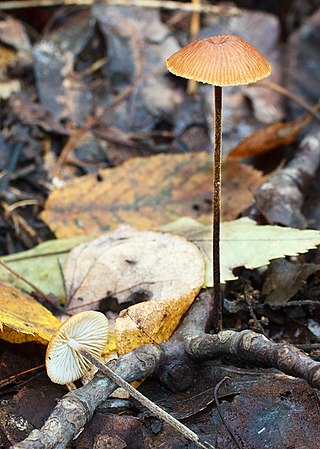
Rhizomarasmius is a genus of fungi in the family Physalacriaceae, containing about five species.

Amauroderma is a genus of polypore fungi in the family Ganodermataceae. The genus, widespread in tropical areas, contains about 70 species. Amauroderma fungi are wood-decay fungi that feed and fruit on decayed branches and trunks.

Marasmius rotula is a common species of agaric fungus in the family Marasmiaceae. Widespread in the Northern Hemisphere, it is commonly known variously as the pinwheel mushroom, the pinwheel marasmius, the little wheel, the collared parachute, or the horse hair fungus. The type species of the genus Marasmius, M. rotula was first described scientifically in 1772 by mycologist Giovanni Antonio Scopoli and assigned its current name in 1838 by Elias Fries.
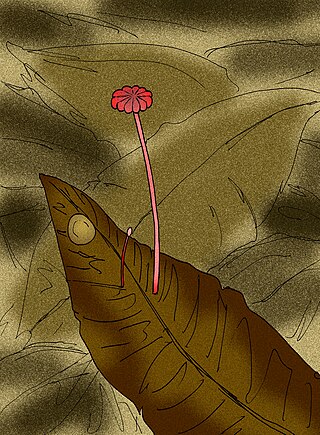
Archaeomarasmius is an extinct genus of gilled fungus in the Agaricales family Tricholomataceae, containing the single species Archaeomarasmius leggetti. It is known from two fruit bodies recovered from amber, one consisting of a complete cap with a broken stem, the other consisting of a fragment of a cap. The cap has a diameter ranging from 3.2 to 6 mm, while the stem is 0.5 mm (0.02 in) thick. Spores were also recovered from the amber, and are broadly ellipsoid to egg-shaped, measuring roughly 7.3 by 4.7 μm. The species, which resembles the extant genera Marasmius and Marasmiellus, is inferred to have been saprobic on plant litter or other forest debris.

Psilocybe allenii is a species of agaric fungus in the family Hymenogastraceae. Described as new to science in 2012, it is named after John W. Allen, who provided the type collection. It is found in the northwestern North America from British Columbia, Canada to Los Angeles, California, most commonly within 10 miles (16 km) of the Pacific coast.
Naiadolina is an agaric fungal genus that produces striking, yellowish fruit bodies on sedges in wetlands in eastern Canada. The lamellae are merulioid, forked and anastomosing. The type species was previously classified as a Marasmius in the Marasmiaceae, but phylogenetically, Naiadolina flavomerulina is in the Physalacriaceae sister to the genus Cryptomarasmius.
Cibaomyces is an agaric fungal genus found in China, Japan, France, and Germany in forests containing Fagaceae. It resembles Hymenopellis radicata because of its size, radiating stipe and glutinous cap. Unlike species in the genus Hymenopellis, Cibaomyces produces spiny basidiospores. DNA sequence data show it to be distinct from Dactylosporina, another spiny-spored genus in the Physalacriaceae.

Butyriboletus is a genus of fungi in the family Boletaceae. The genus was circumscribed in 2014 by mycologists David Arora and Jonathan L. Frank to accommodate "butter bolete" species that were shown by molecular analysis to be phylogenetically distinct from Boletus. Butyriboletus contains 24 ectomycorrhizal species found in Asia, Europe, North America and north Africa.
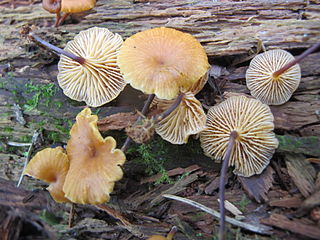
Xeromphalina cauticinalis is a species of agaric fungus in the family Mycenaceae. Originally described in 1838 by Elias Fries as Marasmius cauticinalis, it was transferred to the genus Xeromphalina by Robert Kühner and René Maire in 1934. It is found in North America, where it fruits in the summer and autumn singly or in groups on the seeds, needles, and sticks of conifers, and sometimes on aspen leaves. The fruit bodies have convex yellowish caps measuring 0.5–2.5 cm (0.2–1.0 in) in diameter supported by a tough yellow-brown to dark brown stipe that is 3–8 cm (1.2–3.1 in) long by 1–2.5 mm thick. The pale yellow gills have a decurrent attachment to the stipe and are somewhat distantly spaced. The spore print is white, while individual spores are elliptical, smooth, amyloid, and measure 4–7 by 2.5–3.5 µm.

Marasmius fulvoferrugineus is a species of agaric fungus in the family Marasmiaceae. Described as new to science in 1976, it is found in the southeastern United States. The mushroom is frequently confused with Marasmius siccus, and microscopy is needed to reliably distinguish between them.
Paraxerula is a genus of fungi in the family Physalacriaceae. It was circumscribed in 2010 by mycologist Ron Petersen to replace Xerula section Hyalosetae, proposed by Heinrich Dörfelt in 1984. Petersen originally included P. caussei, P. hongoi, and the type species P. americana. The Chinese species P. ellipsospora was added to the genus in 2014.
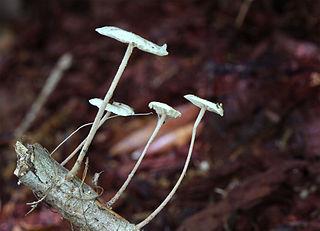
Mycetinis querceus is one of the garlic-scented mushrooms formerly in the genus Marasmius. It has a reddish brown stipe, and usually grows on fallen oak leaves.

Rhizomarasmius epidryas is one of a group of mushrooms formerly in the genus Marasmius. It grows amongst dwarf shrubs of the genus Dryas in arctic or high mountain environments.

















